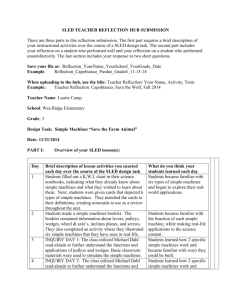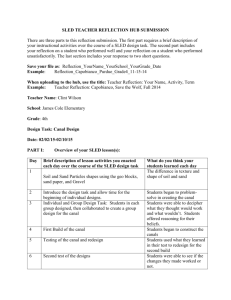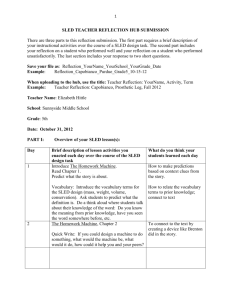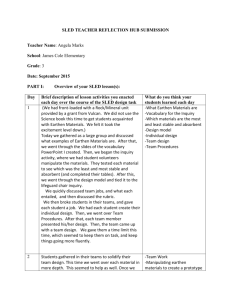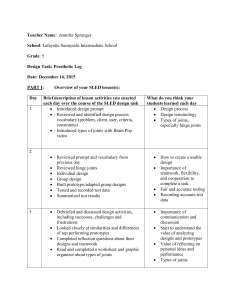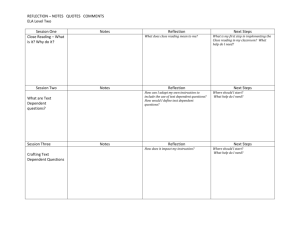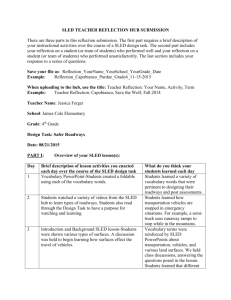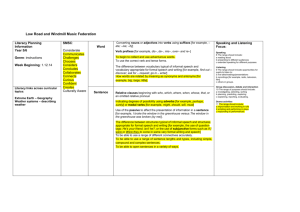objects journal
advertisement
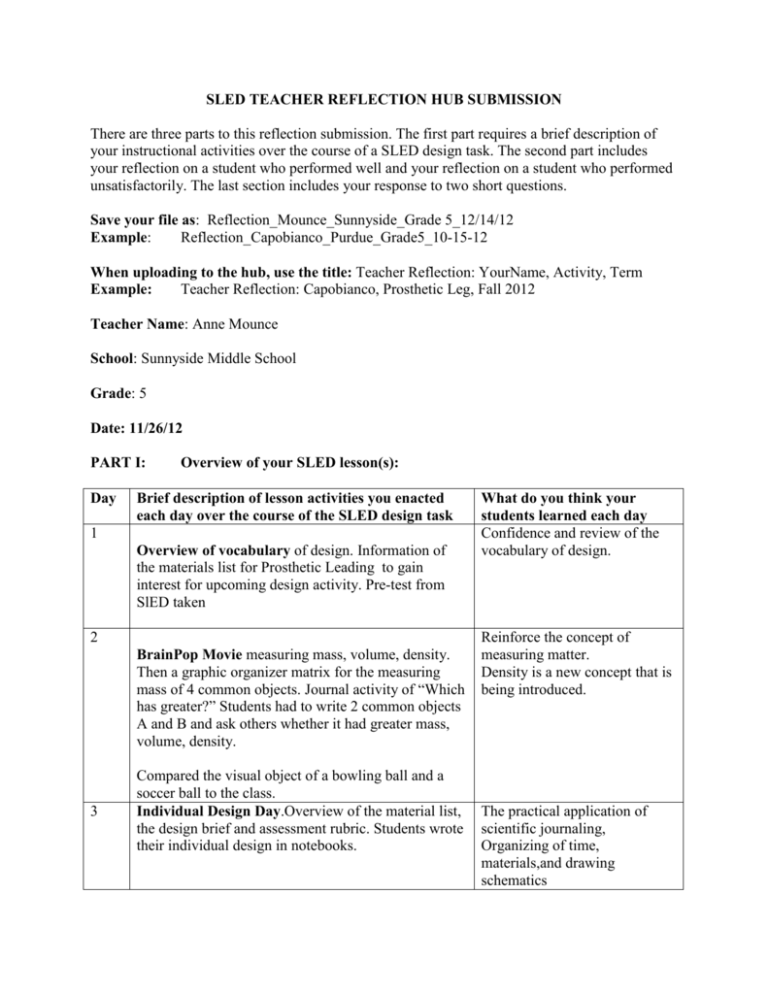
SLED TEACHER REFLECTION HUB SUBMISSION There are three parts to this reflection submission. The first part requires a brief description of your instructional activities over the course of a SLED design task. The second part includes your reflection on a student who performed well and your reflection on a student who performed unsatisfactorily. The last section includes your response to two short questions. Save your file as: Reflection_Mounce_Sunnyside_Grade 5_12/14/12 Example: Reflection_Capobianco_Purdue_Grade5_10-15-12 When uploading to the hub, use the title: Teacher Reflection: YourName, Activity, Term Example: Teacher Reflection: Capobianco, Prosthetic Leg, Fall 2012 Teacher Name: Anne Mounce School: Sunnyside Middle School Grade: 5 Date: 11/26/12 PART I: Day Overview of your SLED lesson(s): Brief description of lesson activities you enacted each day over the course of the SLED design task 1 Overview of vocabulary of design. Information of the materials list for Prosthetic Leading to gain interest for upcoming design activity. Pre-test from SlED taken 2 BrainPop Movie measuring mass, volume, density. Then a graphic organizer matrix for the measuring mass of 4 common objects. Journal activity of “Which has greater?” Students had to write 2 common objects A and B and ask others whether it had greater mass, volume, density. 3 Compared the visual object of a bowling ball and a soccer ball to the class. Individual Design Day.Overview of the material list, the design brief and assessment rubric. Students wrote their individual design in notebooks. What do you think your students learned each day Confidence and review of the vocabulary of design. Reinforce the concept of measuring matter. Density is a new concept that is being introduced. The practical application of scientific journaling, Organizing of time, materials,and drawing schematics 2 4 Team Design Day. Students were placed in groups of three, and brainstormed what design would be successful for their team. After planning/designing time, they brought a materials list to the supply table and purchased items for their design. Once a supply was purchased, there was a no return policy. Sketches were to match the team in individual notebooks. Ample time was given for the construction of the design, and an informal wrap-up of the day was given. Performance, cooperation with others 5 Team Testing Day. Discussion of fair testing and what was a strike of the ball so all students could compare same results. Final discussion of the assessment rubric and how scoring would take place. Individual, team and summative assessments were taken. Journal write-up of what science concepts worked and what did not. Measurement, estimation, prediction of results 6 Final Grade/Wrap-Up. Students received their rubric grade for performance assessment, took the post-test Sled Prosthetic Leg test. Movie Celebration: Winter Students went to the auditorium viewed the documentary which showed the real application of prosthetic design. Retaining design, mass, volume and density vocabulary. 7 How design is used in the world Please answer the questions below: 1. What worked well? I was very impressed at how well the students used the design process and the science notebook. They were much improved and more patient with the process. They wrote schematics and redesign and seemed to accept the continuing progress of the design. 2. What are two ways you can improve your efforts toward integrating design? *Provide more opportunities to the design process. * Allow more time for the re-design process. 3 PART II: Reflection#1 on student performance: Include an image of work from one student who you thought performed well on the task. Insert the image here within the Word document. This image may be a copy of the student’s notebook entry(s) or an image of the team’s artifact or an actual picture of the student at work. SSMS-WORKRO1212 1416130.pdf Insert image(s) here In the space below describe what the image(s) is about and why you would explain or characterize the student’s performance as mastery or excellent. This student on the first attempt clearly labeled his individual design, added the cost, and had a good understanding of design for a prosthetic leg. He seemed like a great Team Designer and would be ready to do a team design. His performance with others was cooperative, and he was able to use his individual design to help design a new plan. 4 Reflection#2 on student performance: Include an image of work from one student who you thought did not perform as well (unsatisfactory) on the task. Insert the image here within the Word document. This image may be a copy of the student’s notebook entry(s) or an image of the team’s artifact or an actual picture of the student at work. Insert image(s SSMS-WORKRO1212 1416190.pdf ) here In the space below describe what the image is about and why you would explain or characterize the student’s performance as unsatisfactory. This student had no labels for his individual design, no schematic, no list of materials, and generally did not have an understanding on how this his design would work. His performance with the team design showed little creative input and really did not take the task seriously. 5 PART II: Reflection #3 Describe one thing you enjoyed about instructing this SLED task. It provides student an opportunity to be creative but logical thinkers. It applies the science concepts of mass, volume and density in practical, concrete terms. Instead of reading about this from textbooks they had a chance to apply these terms. Describe one thing in your practice you would improve upon next time you implement this engineering design task or another SLED design task. Perhaps I could have more time for multiple testing and redesign. I think the confines of testing made it disappointing for students if the ball didn’t go as far as they anticipated. I always like to end an activity with students feeling they had been successful. I know they all felt satisfaction in its completion, but the edge of competition made it hard to accept if the ball only went 10 cm.

